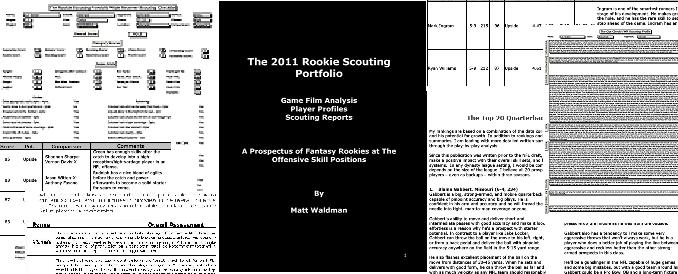
It’s been a productive summer and fall at the RSP Film Room. I am closing in on finishing play-by-play evaluations of 130 different skill position players as my winter vacation is ending and I thought I’d provide a few highlights of what I’ve seen this week. Most of this is lighthearted analysis in three short segments: My Readers Are Smart…But My Wife Might Be Smarter; Duke Johnson: Signs of a Waldman Family Apocalypse; and Big Nasty.
My Readers Are Smart…
I love when I write about one player and I get numerous questions about a different one. This happened with my analysis of Justin Hunter. The Tennessee wide receiver is a freakish talent, but potentially one of the riskiest players at the top of this draft class because of poor habits on both the practice field and on game day. My readers continued to ask me about his teammate Cordarrelle Patterson. I knew I’d eventually get to Patterson but I waited for my vacation because I figured I was going to see something fun and when I enjoy watching a player, I get so pumped up that I have trouble sleeping if I’m studying games at night. Patterson hasn’t disappointed:
[youtube=https://www.youtube.com/watch?feature=player_detailpage&v=hIZwwkdSjiY#t=72s]
His 44-yard run after the catch for a 58-yard gain was just one of many like it. In fact, I wonder if Patterson’s terrific instincts and vision in the open field are making Hunter try to do the same things – and fail miserably at it. Hunter is so gifted, I sometimes think he’s trying to mimic his teammate and is in denial that he can’t match Patterson.
But My Wife Might Be Smarter.
The best highlight of the night was probably what happened after my wife walked into the office, saw Patterson make this run, and asked me his name. When I told her, she said that with a name like that he’s probably from South Carolina. Sure enough, Rock Hill, S.C.
I had to test her further.
“How about Stepfret Williams?”
“Definitely, from the South.”
“Well yeah, but what state?”
“Probably the South a lot of folks up North are scared about – rural Alabama, Mississippi, Louisiana.”
Yep, Louisiana. If this were a game at a fair, we would have enough giant stuffed animals to start an E-Bay business if we weren’t banned from the theme park altogether.
Duke Johnson: Signs of a Waldman Family Paradox
My wife went to school at UNC Chapel Hill. According to her, I have to say the Chapel Hill part or else I’m not qualifying it correctly. A native North Carolinian is particular about their UNCs. When I’m feeling like getting a rise out of her I bring up the Tar Hell-Blue Devil rivalry and it’s the only time I get threats about divorce. [Editor’s Note: This was a complete Freudian slip on my part. It is “Tar Heel.” Unless of course, you’re a Dukie.]
“Alicia, what if one of our kids wants to go to Duke?”
“No kid of ours will ever go to Duke. Why are you even asking me such a stupid question?”
“Wait a minute, you mean to tell me that if one of our kids earned a scholarship to Duke, they couldn’t go?”
“Again, this is a dumb-ass question. Our kids will know that Duke is kidding itself when it says it’s the Harvard of the South. Who says that? Harvard is Harvard. Stop. It’s over. You haven’t gotten in. If you have to describe yourself on the back of another school then you know what’s really going on there.”
“So what if our kid earned a basketball scholarship to Duke?”
“Our kid will earn an academic scholarship and will be smart enough to realize that most Duke ball players wind up playing in Europe.”
“What if our kid chooses Duke because there is a specific program that few other schools of its quality offer?”
“Then you’re gonna have to move out and live in Durham with them in an apartment and you ain’t comin’ back home, that’s for sure.”
With lines drawn like these, it stands to reason that the only “Duke” that I can mention in the house without risking a night on the couch is the one who shares my wife’s maiden name and plays at my first university – Miami. Even so, when I invoke his name she gets a look on her face like I named a kid Hitler Rosenberg, or Hashtag Smith. If you haven’t seen the freshman running back, check out these two touchdown runs against Boston College. You’ll be hearing a lot about this ACC Freshman of The Year soon enough.
[youtube=http://youtu.be/7VGs_szTbwo]
Johnson reminds me of that old East Carolina Johnson. Perhaps not as fast, but the new Miami version has even better balance.
Big Nasty
The tight end class might be the gem of the skill positions in the 2013 draft. Cincinnati Travis Kelce is one of many impressive prospects I’ve watched this year, including this weekend. He’s one of the best blockers I’ve seen at the position and because Cincinnati runs a pistol offense, Kelce plays the H-Back role to perfection. His dimensions are Gronkowski-like and he’s a big, aggressive, and nasty run blocker. He also has fluid athleticism and at 265 pounds, you don’t see a tight end move like this unless he has starter potential in the NFL.
[youtube=http://youtu.be/nBIK_P5c6c4]
I know the Washington Redskins have Fred Davis, but as I mentioned to my Football Outsiders cohorts this weekend, if Washington wants to find a player who can take over if Davis’ Achilles tear doesn’t recover sufficiently, or he opts to sue himself and represent both parties in a court of law, Kelce would be a fantastic fit for Robert Griffin. Then the “Shanaclan,” – as my buddy Bloom calls Mike and Kyle – can end the Niles Paul-tight end experiment and keep him as a receiver and kick return specialist.
Happy New Year!












































